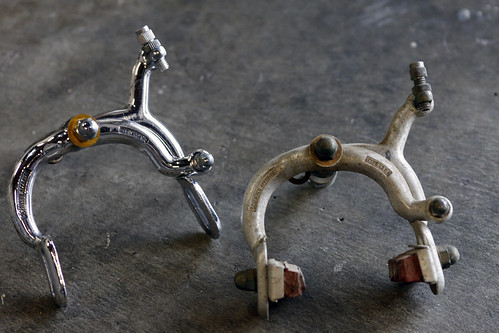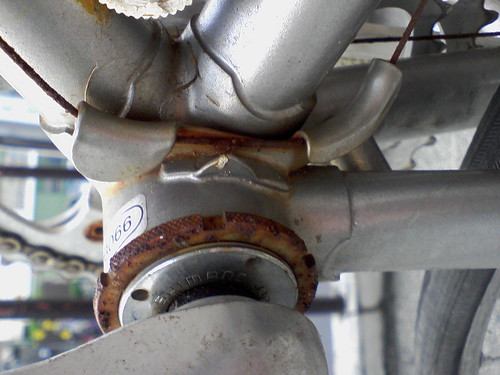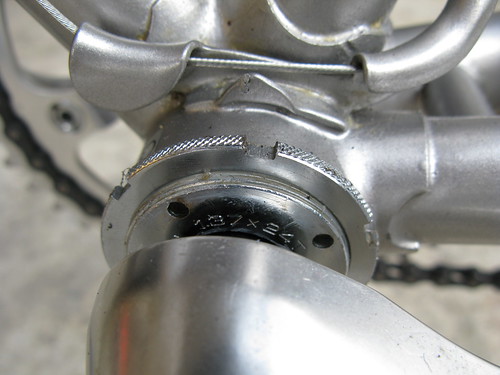Rust Removal on Painted Frame
I'm rehabing an older Schwinn and it has a lot of rust spots where the paint chipped off. I've cleaned the whole frame and am trying to figure out how to remove the rust without damaging the paint. Any suggestions?
Tags:
Replies to This Discussion
-
Permalink Reply by Skip Montanaro 0mi on September 11, 2013 at 6:27am
-
White vinegar or Bar Keeper's Friend (contains oxalic acid) should help. I've used both. Obviously, the vinegar route works better when you can immerse the part (for a few hours). The BKF route works will with a damp rag or old toothbrush.
-
Permalink Reply by Lisa Curcio on September 11, 2013 at 6:34am
-
Flitz Metal Polish available at some hardware stores and at West Marine on North Avenue. Would probably be cheaper at a hardware store because anything that is sold in a marine store is marked way up! :-)
-
Permalink Reply by David P. on September 11, 2013 at 9:35am
-
This was suggested to me when I was looking to do the same sort of freshening on a frame that I have:
I have not tried it yet, though.
There is also Naval Jelly.
-
Permalink Reply by BruceBikes on September 11, 2013 at 10:11am
-
I think naval jelly wouldn't be good on the paint, but damn, it eats rust better than anything.
Related tip: it's great on rusty/pitted chrome. Eats all the rust out of the pits and leaves the chrome all shiny. I've done this on old Schwinn handlebars and rims with great results.
David P. said:This was suggested to me when I was looking to do the same sort of freshening on a frame that I have:
I have not tried it yet, though.
There is also Naval Jelly.
-
Permalink Reply by NYC (7.0 mi) on September 12, 2013 at 2:32am
-
spray some WD40 on the rust area and scrub with a nylon brush.
-
Permalink Reply by Matt Talbert on September 12, 2013 at 2:54am
-
I recently had to remove some rust from an old tandem I am trying to restore. I got some drill bits with a metal brush/scrubber thingy attached and went to town on it. The problem is you will scrape the paint off. If you are planning to repaint, which you usually have to do with rust, this is the best solution. The torque of the drill will really get that rust off.
Make sure you have a mask on, as little rust particles floated off and became breathable. I also wore safety goggles, but that is just me being neurotic.
-
Permalink Reply by Skip Montanaro 0mi on September 12, 2013 at 3:04am
-
Matt Talbert said:Make sure you have a mask on, as little rust particles floated off and became breathable. I also wore safety goggles, but that is just me being neurotic.
Neurotic? Unlikely. Paranoid? Sure. :-)
That said, eye, lung and ear protection are never bad ideas.
-
Permalink Reply by Allen Wrench on September 12, 2013 at 4:38pm
-
Naval jelly. Don't put it on the paint. Same stuff is in Coca Cola, phosphoric acid. May need to stay for awhile to get all the rust. Leaves a layer of iron phosphate (hazy) on your bike but it's a good base for touch up paint, from the auto parts store. It will need paint or primer soon since it will re-rust otherwise.
Any of the methods above work fine for the rust, but it all eventually comes back to the repaint job. Get as close to perfect as you can but don't sweat it.
Chrome looks better with auto parts store chrome cleaner, like turtle wax brand or similar. And scrub the frame with polishing car wax, missing the cool old decals. Compound can get really bad areas clean.
Wax it afterwards to keep it young.
I like the gloves, goggles, mask approach. Why lose your eyesight over a piece of rust?
-
Permalink Reply by Drewbacca on September 12, 2013 at 5:25pm
-
Good advice above, especially from Allen Wrench... hex of a guy.
I've applied naval jelly quite liberally without worrying about getting it on paint... I've never damaged any paint after several restorations. The phosphoric acid reacts with the rust (iron oxide), a chemical reaction that only takes a few minutes to form iron phosphate... for the remaining acid to do any damage to the paint, it would take a lot longer (I imagine days, but I really have no idea since I haven't pushed it in order to find out).
It's good to followup with frame-saver on the inside and some sort of rust-stop paint on the outside (ideally something containing zinc which will be a sacrificial anode). If you go with a basic rust converter (which is also phosphoric acid mixed with a primer) try to find the loctite brand (the rustoleum rust converter stuff doesn't work). I just picked up a bottle of Jasco brand to use on my car, but I haven't had it on long enough to make a comparison to the other two brands). That said, the rustoleum heavy-rust formula with the added zinc is decent, just not their phosphoric acid based converter.
Before you get too crazy, a little steel wool will work wonders. Just remember to always use a clean piece because you can cross contaminate rust and start the rust cycle in an otherwise clean spot. Same thing with a wire brush... you can actually contaminate stainless steel with rusty metal if you are careless with cleaning tools.
My usual system is this:
Wipe vigorously with rubbing alcohol to remove all loose rust. Apply naval jelly, wait ten minutes and wipe off. Clean with rubbing alcohol. Reapply naval jelly. Continue as many times as necessary to remove multiple layers of loose rust. Then I use a metal prep, usually the loctite rust converter I mention above (we used this for frequently in the engine room while I was in the navy, it works well). Once dry, I apply a second coat (this is also my primer). Then I apply a coat of enamel (usually basic testor's model enamel which is close to matching on most bikes). I find that it's best to apply a very small amount at a time with a tooth pick. Give it about a day between coats for the best results, but you can add a few coats back to back on a deeper cut. If you apply too much enamel, you can vigorously rub it with rubbing alcohol (after 48 hours) and get it nice and level with the old paint... it will be a bit dull and will need another coat to restore the shine.. If the paint gets too dark in the later coats, remove the coats and mix the enamel with a clear coat to dilute the color and reapply. Wait a month to ensure full drying, then put some wax on there!
-
Permalink Reply by Reboot Oxnard on September 13, 2013 at 1:24am
-
Phosphoric acid is pretty much the gold standard for rust removal prior to painting. It converts the iron oxide to iron phosphate which is water soluble and easy to remove. Iron phosphate is also chemically stable and can be directly painted over, though it leaves a rough finish. It's available at most hardware stores as Miracle Sealant but I've had better results from this stuff - harder to find (check with scuba stores) but it's diluted to a "won't dissolve your hand" strength and buffered and provides very good results. As an aside, phosphoric acid is the stuff that makes Coke or Pepsi dissolve things - it's "safe" to eat.
Oxalic acid is a pretty good alternative. It, too, converts the iron oxide to a more easily removable substance and/or is chemically stable and can be painted over. Oxalic acid is the magic in Bar Keeper's Friend - but can be purchased without the abrasives in Wood Bleach. This stuff isn't good for you - it maybe carcinogenic - but it is a little gentler than phosphoric acid.
Acetic acid is probably the least effective. It takes a lot of time and will need to be refreshed more often but it will get the job done if you're patient. Acetic acid is what makes vinegar vinegar, the cheap white stuff is the best for this purpose but you can find undiluted if you look hard enough.
All acids are hard on paint, it's just the nature of the beast. Sometimes that's a good thing: etching a painted surface helps new paint adhere better but you may not want an etched surface.
-
Permalink Reply by Far'arned Retrogrumpalunkus #63 on September 13, 2013 at 3:25am
-
Oxalic Acid is the go-to magic bath used by most serious amateur bike restorers for rust on steel. There is a lot of discussion on it at bikeforums.net
It's not great on aluminum.
Read up on it. It's really very simple and won't harm paint, although on some really old bare metals it will darken them, especially older vintage nuts/bolts and spokes that have very old galvanization. OA works very well on chrome, even very rusted and pitted chrome. It does great on frames too if you can get a big enough basin to use it in, like a kiddie pool.
Doesn't hurt paint or decals even. The secret to Oxalic is that it is not a very strong acid, it just likes to bond to rust and convert it to an easily washed/brushed-off greenish salt that just goes away.
This image alone shows the power of OA
These too:
-
Permalink Reply by Marcus Moore on September 13, 2013 at 5:28am
-
James- that brake looks great. You did that with OA? Followed up with polishing?
You mention it's not great with aluminum, but this caliper is aluminum... What other precautions do you recommend when working with alloys?
James BlackHeron said:
Groups
-
Chicagoland Beer Explora…
203 members
-
Wednesday Night for Mort…
1 member
-
Great Lakes Ultra Cycling
270 members
-
Major Taylor Internation…
1 member
-
Critical Mass discussion
261 members




